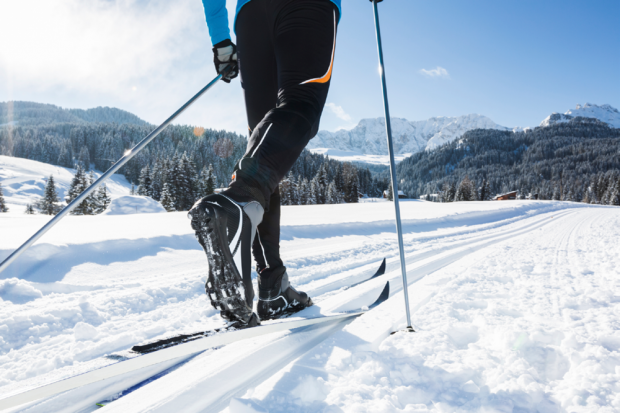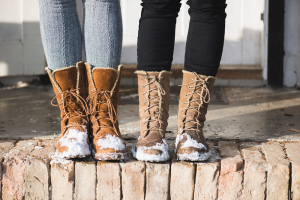Foot Health For Skiers Ski Safety Tips: Avoiding Foot Injuries While Skiing
Here’s everything skiers need to ‘snow’ about avoiding injuries and keeping their feet protected while skiing.
The last thing you want during an exhilarating ski trip is a sudden foot injury that zaps the fun out of your vacation and brings everything — including your mood — downhill. But how can you avoid skiing injuries like ankle sprains, bruises, blisters, frostbite, neuromas and other painful, debilitating foot ailments? By following these simple ski safety tips, of course!
Avoiding Ankle Sprains and Twists
Ankle injuries used to be fairly common among snow skiers, but according to the Family Foot and Ankle Clinic in Austin, Texas, the number of ankle-related ailments has gone down significantly in recent years due to advancements in ski boot designs. There is still a risk of twisting or spraining an ankle, however, so always make sure you’re wearing well-fitted ski boots with properly adjusted bindings to reduce your risk of ankle injuries.
Avoiding Blisters
Blisters are painful, liquid-filled bumps that arise due to repeated friction on the skin. Wearing properly fitted ski boots and frequently changing into dry socks can help decrease the number of blisters skiers get while engaging in the sport, but it’s almost impossible to avoid blisters altogether. Try rubbing a small amount of Vaseline on your feet to ward off irritation from friction or use bandages, tape or moleskin on areas you know are likely to be susceptible to blister formation.
If you develop a blister despite following these safety tips, check out How to Banish Blisters and Relieve Blister Pain.
Avoiding Bruises
As much fun as skiing can be, it’s also a sport that really beats up your feet, ankles and knees. One of the best ways to avoid bruises from developing on your body when you fall is to wear proper gear from head to toe, including a helmet, padded clothing, gloves or mittens, properly fitted ski boots and thick, warm socks.
Avoiding Frostbite
Though it’s not a common threat for skiers who avoid backcountry and wild terrain, frostbite is a cold weather reality that can affect skiers and snowboarders alike — whether on official resort trails or off the beaten path. Frostbite is an injury that occurs when the skin and underlying skin tissue become cold and start to freeze. And what most people don’t know is that frostbite can affect feet, toes, hands and fingers that are covered in gloves and socks. So what is a skier to do in order to avoid frostbite from setting in? Try not to remain outdoors for extended periods of time, especially when the weather is extreme. Always wear proper cold-weather gloves, socks and other clothing. Make sure your socks and ski boots aren’t too tight, which can limit blood circulation. Stick to official ski resorts or slopes that offer mountain patrol in case of emergencies. And never go off the beaten path when you’re alone.
Avoiding Morton’s Neuroma
Experts disagree on why skiers tend to be susceptible to developing Morton’s neuroma, a condition in which the tissue that surrounds the plantar nerve in the foot thickens and creates pain. One theory is that when skiers' feet are continuously squished into ski boots that are too tight, the plantar nerves are pinched and become extremely irritated over time. A simple way to avoid this painful condition from happening is to wear properly fitted ski boots that are snug but aren’t too tight.
If you have a pre-existing condition of Morton's neuroma, it’s important to visit a podiatrist or health care professional as soon as possible. Early diagnoses can help slow a neuroma’s progression and lessen the need for invasive surgical treatment. Furthermore, a podiatrist can prescribe custom orthotics and/or suggest physical therapy exercises to help strengthen the foot muscles and alleviate Morton’s neuroma pain — both of which will keep you on the slopes for years to come.
Avoiding Other Skiing and Snowboarding Injuries
According to the National Ski Areas Association (NSAA), there were 42 catastrophic ski injuries and 35 ski or snowboard related fatalities during the 2014/2015 season. The only way to avoid becoming a statistic yourself is to follow safety guidelines designed to help keep you and fellow skiers and snowboarders safe. Additional ski safety tips include:
- Always adhere to posted signage and follow resort/mountain patrollers' orders
- Wear proper skiing and snowboarding gear and equipment, including helmets, goggles, gloves, ski poles, warm socks, and properly fitted and functioning boots and bindings
- Use caution when riding ski lifts and when hopping on or off the lift
- Use extreme caution when skiing or snowboarding off official trails and in backcountry, as both frostbite and avalanche injuries/fatalities are more common in sports enthusiasts who freestyle outside of patrolled areas
- Routinely correct poor skiing technique to help avoid common injuries like a torn ACL, ankle sprains and wrist injuries
- Closely monitor your feet and lower extremity circulation if you suffer from conditions like diabetes, peripheral arterial disease or Raynaud’s phenomenon, as cold weather and tight ski gear contribute to poor circulation already experienced with these conditions
Notice concerning medical entries:
Articles having medical content shall serve exclusively for the purpose of general information. Such articles are not suitable for any (self-) diagnosis and treatment of individual illnesses and medical indications. In particular, they cannot substitute for the examination, advice, or treatment by a licensed physician or pharmacist. No replies to any individual questions shall be effected through the articles.






